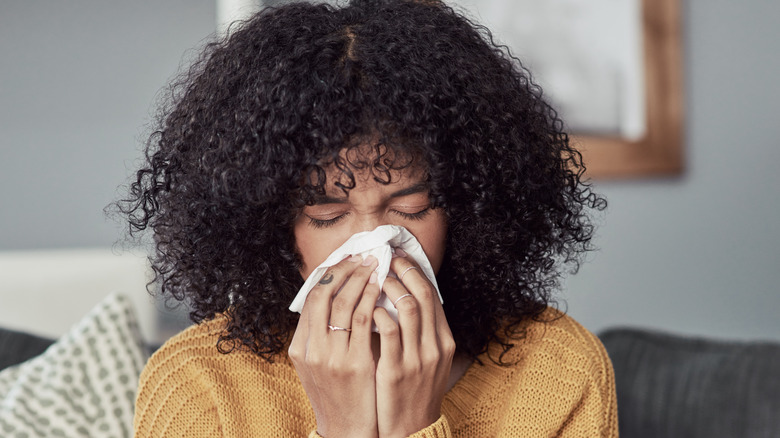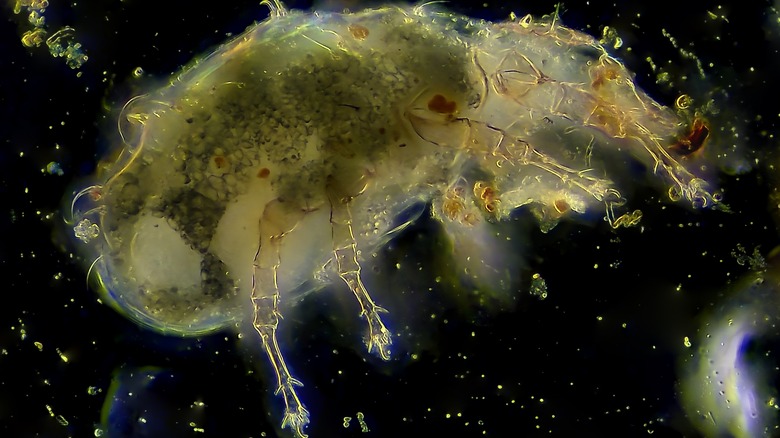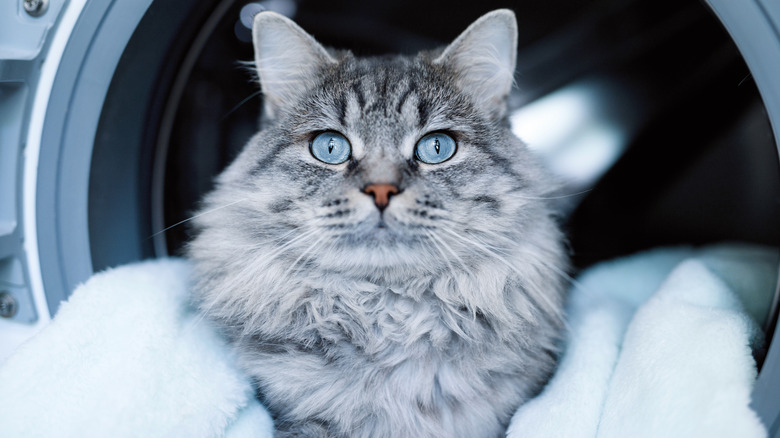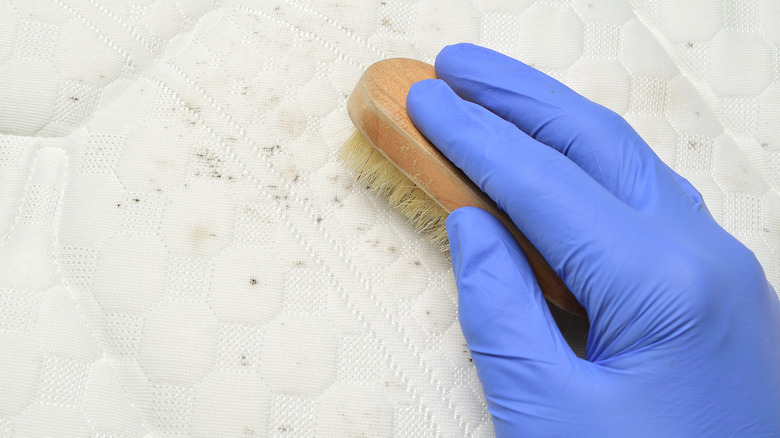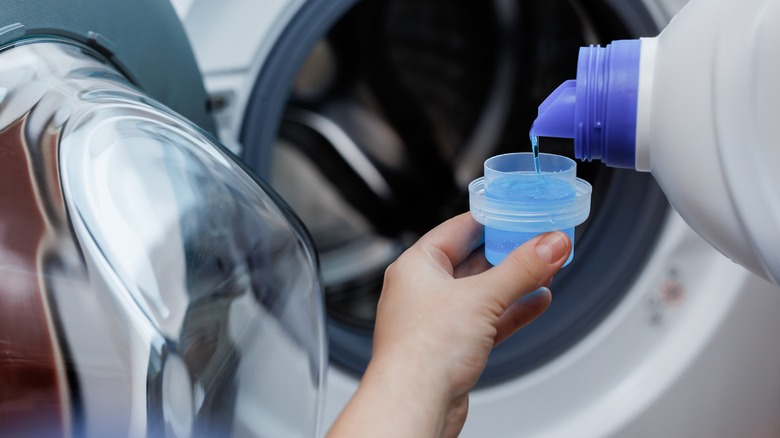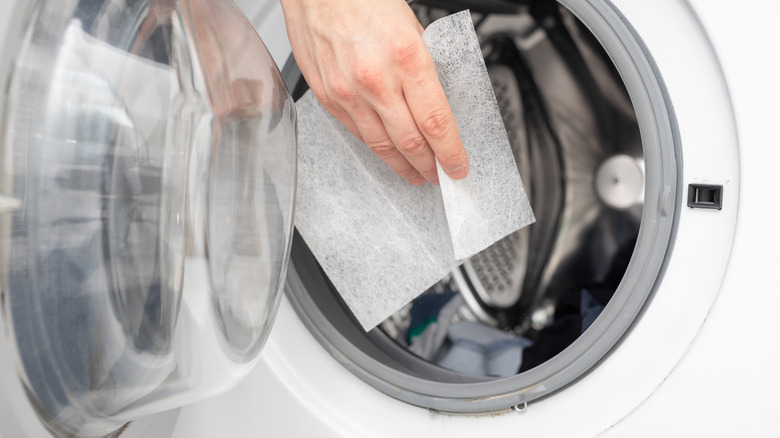Common Laundry Allergens And How To Avoid Them
Common allergies can be pesky to deal with on a daily basis, and unfortunately, they seem to continuously plague our lives with runny noses, scratchy throats, and itchy eyes. The Asthma and Allergy Foundation of America (AAFA) found that over 100 million people in the United States encounter some allergy every year, with allergies being "the sixth leading cause of chronic illness in the U.S." Many allergies we experience manifest directly in our homes, especially when it comes to our laundry.
Fabrics such as clothing, bedding, and furniture hold all kinds of allergens. From dust mites, animal dander, and mold spores to chemicals in detergents and fabric softeners, our laundry can be covered in allergens that leave us feeling unwell. Still, with tips on how to wash and dry your clothes and what soaps, soaks, and solutions you should use, you'll find yourself feeling refreshed and allergen-free in no time.
Dust mites
Dust mites are one of the more common home allergens that people experience. These microscopic insects thrive in muggy conditions and live off of our dead skin cells. While dust mites can't be seen with the naked eye, it's prevalent to feel their presence in the form of allergies. Dust mites won't directly cause you any harm, like biting, stinging, or burrowing into the skin. However, the proteins in their urine, feces, and remains can cause allergy flare-ups of rashes, congestion, irritated eyes, sneezing, and coughing. They hide away in many areas of the home, including mattresses and bedding, furniture, carpet, and clothing.
Luckily, by using several methods, reducing dust mites in our laundry is possible. Washing clothing in hot or warm water rather than colder temperatures will significantly remove the mites from fabrics. Detergents with bleach will be effective, as will allergy-friendly laundry detergents or specially formulated additives that target dust mites. Washing clothing and bedding once a week will help stay on top of the issue, and drying laundry in hotter temperatures also helps reduce any dust mites that survived the wash. Keeping dust mites out of the home overall will result in fewer laundry infestations, so avoid high humidity where possible, keep up with dusting, and consider allergen-proof bedding options.
Animal dander
Our furry friends can often be some of our best companions, but unfortunately, pet dander can be a severe health hazard. The AAFA found that 7 out of 10 U.S. households have pets, with cat and dog allergies affecting up to 20% of the global population. Animal dander includes an animal's dead skin cells and the proteins in their urine, feces, and saliva, which easily stick to our fabric surfaces. Those with pet allergies will see symptoms of a runny nose, itchy eyes, sneezing, dermatitis, and difficulty breathing. Pets that don't have fur aren't at risk of setting off these allergies, but even if you don't have a mammal occupying your home, you can still carry dander in from other places.
Removing animal dander from clothing can be a tedious task, but one that is worth it for those experiencing allergic reactions. Before washing clothing that was exposed to an animal, try removing all hair or dander possible with a lint roller or tape. Running laundry in the dryer before placing it in the wash can also help as it softens the fabric and removes loose and excess particles. A vinegar soak can also give a similar result. When washing, try not to overload so that rinsed-off dander can easily be filtered out and drained away, and consider using anti-allergen detergent. Use dryer sheets and wool dryer balls to collect the remaining hair after the wash, and always empty out the lint trap after each cycle.
Mold spores
The issue of mold spores in your laundry may not seem overly concerning to you. Still, you do not have to have mold growing on the walls or a giant ball of wet and mildewy clothes in the corner to have the environmental allergen present in your fabrics. Simply walking home in the rain or spilling a drink on your blouse can lead to spurring spores, as moisture sustains mold. Natural fibers like wool and cotton will be more susceptible to mold growth, but synthetic fibers are also viable for the fungus. The presence of mold can negatively affect anyone, but those with an allergy or who are immunocompromised will suffer at a higher rate from rashes, irritated eyes, shortness of breath, and congestion.
To effectively remove mold spores from your clothing or bedding, you'll want to first soak the items in bleach or hypochlorite before putting them in the wash. You also shouldn't wash non-contaminated items with contaminated ones to avoid the possible spread of the spores. If your detergent is not designed to kill mold, vinegar or bleach will help. Drying the items in high heat or the sun will help kill any mold that survived the wash, and you may want to consider using Mold Armor. The solution helps kill off the mold spores before they release allergens and is a proactive measure you can take.
Detergents
Our laundry detergents contain many ingredients that could cause allergic reactions. If you're experiencing contact dermatitis, difficulty breathing, itching, heated skin, blistering, sneezing, coughing, or headaches with an unknown cause, then it's possibly an issue with your detergent. People often experience adverse reactions to fragrances, preservatives, color dyes, and surfactants in laundry soaps. It's important to distinguish chemical exposure from allergens, as harsh products like bleach may cause itchiness and irritation, but that's different from an allergy.
Detergent fragrances contain hydroperoxides to create pleasant smells, with limonene and linalool frequently used. Preservatives are added to detergents to ensure they don't expire too quickly and can keep out bacteria. However, it's common to have side effects from certain preservatives like parabens. Plenty of paraben-free options are available since this is a common ingredient people try to avoid. Surfactants are another category that can often be the culprit of allergic reactions. Surfactants help create a more flexible consistency for the soap and remove stains and dirt more easily. Frequently used surfactants to look out for include sodium lauryl sulfate, sodium laureth sulfate, and alkylbenzene sulfonate.
If you are concerned about having an allergy to something in your detergent, consider getting tested to learn what products to avoid. You can also experiment with hypoallergenic solutions; use liquid detergents rather than powder to lower product buildup; don't overuse detergent in the wash; and try DIY soap mixes where you'll know precisely what your soap contains.
Fabric softeners
Fabric softeners are yet another item commonly used in laundry routines to enhance the softness of clothing, remove static, and reduce wrinkling. These softeners come in liquid, powder, or dryer sheet form. You can even go as far as using fabric conditioner as well, which helps with the pilling, fading, and stretching of fabrics. While these products seem to be beneficial to our clothing, they may actually be the culprit of allergy and asthma flare-ups. If you are negatively reacting to fabric softener, then you might be experiencing itchy and irritated skin and difficulty breathing.
Fabric softeners contain a number of chemicals and ingredients that could be causing one's allergies, quaternary ammonium compounds (quats) being in most solutions. Quats help create that incredibly soft feeling in clothing after fabric softener is applied, but these compounds are known to cause rashes and stimulate asthma. Being careful with fragrances and preservatives is also wise. Found in fragrances, phthalates and galaxolide are frequent culprits for allergic reactions, while methylisothiazolinone and glutaral also cause reactions and are found in preservatives. Rather than continuing to use fabric softeners, dryer balls are a great alternative, or you can DIY it by adding ½ cup of baking soda or ¼ cup of distilled vinegar to the washer's rinsing cycle. Also, be sure to rewash any items previously exposed to fabric softener before reusing them to avoid any future allergic responses.
